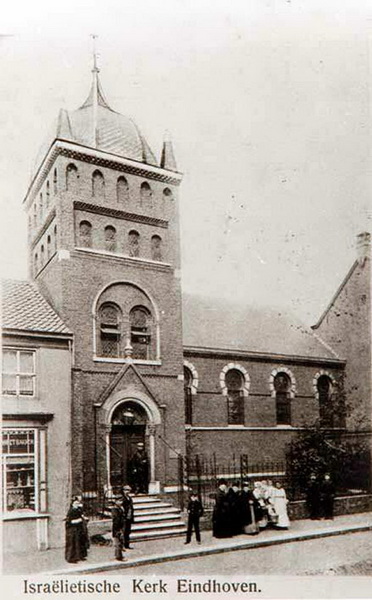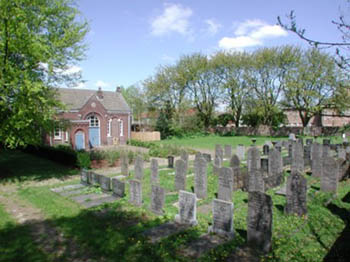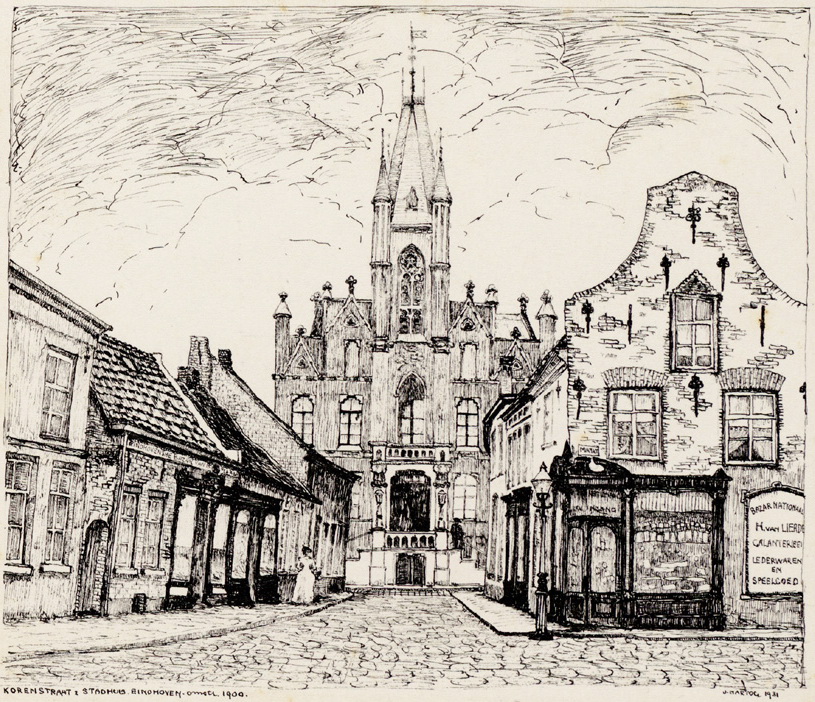The Jewish community of Eindhoven and Surroundings
Source:
"Oasis in a desert," the Jewish Community of Eindhoven (1770-1920),
J. Bader, Breda, 1999.
Introduction
In the 18th century Jews usually settled near the main trading routes, or in the important marketing towns. That was also the case with Eindhoven. The small town of Eindhoven, the name of which came probably from 'the court situated at the end', had approximately 2000 inhabitants around the year 1800.
The town was situated on the road from the town of's- Hertogenbosch to Hasselt and Luik. A weekly market and several year markets were held in the town, a situation that was attractive for the Jews, who were, however, not allowed to stay in Eindhoven overnight and had therefore to live in the surrounding villages, like Woensel, Strijp, Gestel, Stratum and Tongerle. Before 1760 two Jewish families lived in the little village of Eindhoven. Only after 1800, a small Jewish community was formed.
Living in the midst of a dominant Catholic community was not always a simple matter, there was rather much anti-Semitism, but after years of successful enterprise and industrial growth, the Jewish community was gradually accepted. In the second half of the 19th century we find a blooming and prosperous Jewish community in Eindhoven. Around 1930 the Jewish community of Eindhoven was the greatest Jewish one in the province of North Brabant.
It is hard to say when Jews tried for the first time to settle in Eindhoven. Between 1555 and 1819 no Jews with residence rights were registered and during the period from 1710 till 1810 no letters of guaranty or discharge, issued by Jews, were found. This does not mean that no Jews at all resided in town. They were allowed to reside there against a guaranty of 300 guilders, but there were very few who were able to pay such an amount.
In 1695 a butcher named Benjamin Jacobs requested permission to settle in Eindhoven and between 1.4.1697 and 31.3.1698 he paid to the town councellors an amount per person "for himself, for Sara his wife, for the woman servant Eva, for the manservant Gompert and for Gompert the child."
Benjamin Jacobs was, however, unable to maintain his business and in 1697 he went bankrupt, being in debt to several people.
Afterwards, during a period of fifty years, there were no Jews in Eindhoven, or their presence was not noticed or registered.
An incident occurred in 1748. Meijer David "belonging to the Jewish nation and bone cutter here," had bought a cow from a farmer from Veghel. The farmer thought that he had not received a fair price for his cow. With a group of other farmers he went to David's cowshed and took the cow back. It came to a heated exchange of words and blows. Meijer David filed a complaint of maltreatment with the deputy mayors of the town.
In 1766 the number of Jews rose from two till fifteen. Their staying in town was not made very easy and poor Jews certainly could not stay there, due to the high taxes Jews had to pay. A petition to the Prince of Orange, the lord of Eindhoven, was of any help for a short time only. It remained very difficult to obtain a residence permit.
In the large village of Woensel the attitudes towards Jews was somewhat better and in the period between 1771 and 1786 several Jewish families were allowed to settle there.
As a whole, it remained a difficult situation. The deputy mayors of Eindhoven regarded the residence of the Jews as undesirable and dangerous to the hard working citizens of the town, who would be most certainly impoverished by their arrival.
One of the Prince's advisors decided to investigate the matter. As a result the Princely Council decided to empower the magistrate, actually ordering him, to allow the Jews entry from 1 October 1772. "… and the Jewish nation will be tolerated in the town and consequently be guarded by the authorities, as long as they live there and, like all other residents, they will be obliged to pay all municipal taxes and country and town expenses."
Nevertheless, there were renewed efforts to harass the Jews, but the Princely Council took measures to protect them. Towards the end of the 18th century several Jews resided in town, but most of the time they were absent, making their rounds as hawkers.
The synagogue
In 1781 several Jews from Eindhoven bought a house in the Kerkstraat, to serve as a synagogue. Since the Jewish community was not a corporate body, the building was registered under the name of the Treasurer. Towards the end of the century, in 1800, a small synagogue was in use with specific regulations regarding proper behavior in the "shul." Apparently there were difficulties, making this necessary.
Next to the small synagogue there was a ritual bath, a "Mikve," a classroom, and a home for the cantor and teacher. All were property of the Jewish community.
After the French conquest the "Hoofdcommissie tot de Zaken der Israelieten," ("the High Commission of Israelites") was instituted.
In 1809 the synagogue was honored by a very special guest, King Lodewijk Napoleon. The King was received by the Jewish community with great honor, with a welcome speech in French, and that was apparently the reason of his decision to visit the synagogue and even to assist in the building of a new and larger one.
The city government also rendered assistance, by authorizing a collection. Together with a loan, enough funds were raised for the building of a new synagogue, which was inaugurated in May 1810. Many presents were offered at the inauguration.
Sometimes quarrels between the community members were going on even in the synagogue. As a result a second house synagogue was erected on the Stratumseind. Finally the quarreling parties made peace on condition that the "separating members" would return the Torah roll and other objects from the house synagogue to the great synagogue.
To keep order in the synagogue a system of fines was used. If somebody "in schul nicht recht geton hat," he was fined with 18 stuivers.
In January 1813 a reorganization of the Dutch synagogues was instituted. Instead of the former "Opper Consistorie," the central organization of all Dutch synagogues, Holland was divided into six main,synagogual regions, whereby the small community of Eindhoven became affiliated with the region of Rotterdam.
In 1861 the community started the planning of a new and larger synagogue. The planning was a source of much hesitation and worries, because at almost the same spot a new Catholic church was being built, and the Jewish community was afraid that the organ music would disturb the service in the synagogue.
Finally the new synagogue was nevertheless built very near to the church. The inauguration took place in August 1866. Because of the cholera epidemic, raging at that time, it was a modest ceremony.
Neither was the 40th anniversary celebrated in 1906, because of "the sad situation of the Russian brothers in our faith," meaning the terrible pogroms in Russia.
The 50th anniversary in 1916 also passed also without any celebration, because of the First World War. In 1926 the synagogue was entirely renovated and in the fall it was taken into use again.
In 1944 the building was entirely bombed out and after the war the community held their prayers in a residence in the Hendrik Casimir Street.
The Jewish school
Already in 1784 the small village of Eindhoven had a cantor, a butcher and a teacher, at a yearly salary of 150 guilders with an additional 17 guilders for heating. Around this teacher quite a lot of problems arose and he, moreover, did not master the Dutch language. At the time there was rather much anti-Semitism and the Jewish community, which did not want to cause any provocation, decided to cancel the nomination of a teacher altogether, in view of the existing intolerance.
During the 19th century the Jewish community of Eindhoven owned a residence for the teacher and a classroom, which was quite remarkable at the time. In 1809 Jewish children could learn Hebrew and study Jewish subjects at the Jewish school. In 1816 however Jewish schooling was in a sad state. The cantor, also serving as butcher, who was expected to give Jewish lessons, was not up to the expectations. A new teacher, appointed in 1817, was also a disappointment.
One of the community members offered to appoint his private teacher, but even this gesture remained without any positive results.
The situation got better only in 1829, when a Jewish teacher arrived from Poland, who stayed till his departure in 1839.
The appointment of a Jewish teacher depended in a large measure on a governmental subsidy. Therefore there was no constant supply of Jewish teachers. Only after regional reorganization and the introduction of new regulations in 1862, could the necessary attention be given to Jewish education. Even then, teachers did not stay for a long time.
When the former Jewish schools for the poor were closed, all children went to a general school. Only after regular hours the children went to the Jewish school. The rabbi-inspector however was very dissatisfied with the Jewish teaching in Eindhoven. The situation improved only in the eighties.
Till 1859 there was no school management, but the community was obliged to appoint a school commission, usually composed of parents of the children. In 1871 Eindhoven had two Jewish teachers for 50 students, and in 1875 there was only one for 52 students. Not all children went to the Jewish school and some of them studied with a private Jewish teacher of their own.
When the new synagogue was being built in 1866, it was proposed that the old synagogue would serve as the Jewish school. In May 1868 the community temporarily rented the old school locality behind the municipality under one condition: "In case the pupils will not be properly disciplined and will become an annoyance, the permit will be revoked at an earlier date."
In December 1868 the Jewish school was ceremoniously inaugurated, although there were still several private teachers in 1872.
Since the Catholic Church exerted much influence on the schooling system, the community established a so called "departmental school," which was opened in 1876. Within a short time it was nicknamed the "Jewish School," because there were only five teaching days. The school was headed by a Protestant female teacher.
Means of support
During the second half of the 18th century the Jews in Eindhoven were mainly merchants or hawkers. In Tongerle there were also some Jewish butchers.
The Jewish butchers usually sold their meat from house to house, but the non-Jewish butchers regarded this as unfair competition. Finally the Jewish butchers were permitted to sell their meat during four weekdays.
At the start of the 19th century many Jews supported themselves by selling second hand clothing. This was however a risky business because such clothing could convey contagious illness and its source was not always known. Some of it could even have been stolen goods.
Except Jewish butchers and cattle traders, there was also a Jewish tanner, and around 1834 there was a Jewish bakery.
In the second part of the 19th century a change took place. From the sale of second hand clothing many Jews changed to the textile industry. Hawkers became travelling salesmen, or opened a shop. Some of them became manufacturers or successful entrepreneurs. They traded in linen and cotton.
Some family members became doctors and there was also a jurist who specialized in insurance.
Many textile factories, creating employment, were in Jewish hands. There was also a cigar factory, which was even honored with the title of "Royal Purveyor." And the cattle trade remained an important source of income for many Jews.
In order to promote trade and especially to assist small shopkeepers, a
so-called loan fund was established in 1907, financed by well-to-do Jewish firms.
Jews were also employed by the Philips factories. The good conduct of its general manager, Frits Philips, regarding his Jewish employees during the Second World War deserves to be mentioned.
Burial
In 1747 two Jews were murdered on the moors between Best and Oorschot. At the time the region was used by the British army as practice area. With consent of the British officers, both Jews were buried there. Afterwards several Jews from Eindhoven were buried at the same site. The graves however were defiled by wanton boys and shepherds and therefore a petition was filed, requesting that the spot on the moor should become "a dignified resting place for our deceased." They requested a plot of about 230 square meters, fenced with a ditch or a moat. After much hesitation consent was received.
Tongerle also had a Jewish cemetery. In the second half of the 18th century several Jews lived in Tongerle and in 1785 a cemetery on the moorland was established. However, after most Jews had left Tongerle, the cemetery was not in use anymore. At the start of the 20th century the cemetery was fenced off. It still exists, but its present situation is unknown.
The Jews who lived in the villages, preferred to bury their dead not far from their domicile. The burial in a larger cemetery, farther away, was usually too expensive, due to the rights levied when passing a Catholic church.
Therefore they had no other choice, but to reserve a faraway spot on the moor, on land belonging to the municipality. In that way several "Jewcemeteries" were established usually marked by a row of trees, or by a moat. Due to their remote location they were often the target of wantonness and desecration. Most of these cemeteries have long disappeared. They fell into oblivion, and nobody remembered their original destination.
Sometimes they were vaguely remembered by the people as the "Smousencemetery," or the "Jewcemetery."
There were Jewish cemeteries in Eersel, Budel and in Aarle-Rixtel, which were also vandalized.
In 1876 a "metaher" house was added to the cemetery of Woensel. A new structure was built in 1915. In 1909 the church wardens decided to erect a wall around the cemetery. In 1925 and 1926 the cemetery was enlarged and encircled with a new wall. As a result of the growth of Eindhoven this cemetery became a part of the town. It exists till today, like another one on the grounds of the Psychiatric hospital, the "Grote Beek."
Society Life
In 1866 a Jewish children choir, "Bris Neoriem," was established. The choir members were about 15 years old.
In 1870 there was a society in Eindhoven, "Tot Nut en Genoegen," ("Utility and Pleasure"), which founded a choir for the synagogue service. The society was open to everybody, rich, poor, religious or liberal, and aimed at culture and brotherly togetherness. The society organized parties and stage performances. In 1921 it celebrated its 50th year jubilee.
About 1885 a group of well situated people deemed it necessary to meet with their "own" people and they founded the elitist recreation society, "Oefening en Ontspanning," After 1888 no more was heard of this group.
Each respectable Jewish community had a branch of the "Alliance Israelite Universelle" and from 1878 Eindhoven also had a small branch. The main purpose of the Alliance was the improvement of Jewish living conditions around the world. The Alliance also fought expressions of anti-Semitism and discrimination. The Alliance members were usually well-to-do members of the community and successful businessmen. Towards the end of the 19th century the Alliance lost members to the Dutch Zionist movement, which also had a small branch in Eindhoven. However, between 1910 and 1920 Alliance membership rose again from 35 till 50.
Another association, "Gemilus Hasodim," was responsible for the financing and maintenance of the cemetery, as well as for the care of the sick and dying. The members of this association usually were the most religious members of the community and the most loyal visitors of the synagogue.
Since 1887 there was also a women association "Bigdei Koudesh," taking care of the interior of the synagogue and the "sacred garments."
In 1891 "Hachnosas Ourchiem" was founded, taking care of the reception of migrating Jews, fleeing from the pogroms in Eastern Europe.
There was a nucleus of religious Jews in Eindhoven, maintaining traditional Judaism. They were united in "Talmud Tora," dealing mainly with Jewish studies and in "Gemilus Hassodiem." In 1896 they founded a new section, "Shmiras Shabos," which financially enabled Jews to keep the Shabbat.
In the twenties there a ladies' society existed, named "Hogmas Nosjim," for the study of Jewish subjects.
Social care
Not many members of the Jewish community of Eindhoven lived in squalid poverty.
About 1867 one family lived in a house which was declared uninhabitable and a danger to public health. This family moved to Woensel, where the father - without much success - tried to support them by trading in second hand clothing. His wife was constantly ill, which cost money. Sometimes he was obliged to appeal to social care.
Another family, also quite poor, had many children, who were exempt from payment for their schooling.
After the "Poverty Law" (1854-1855) poor Jewish citizens were dependent on the "Poverty Commission" of the Jewish community in Eindhoven. During the period 1854-1868 needy people received steady support, usually during the winter months.
About 1860, 20 % of the total Jewish community at Eindhoven was impoverished, 214 members received steady support and 422 members had to be supported from time to time. Compared to the general population, these numbers were relatively small. The Jewish population of Eindhoven suffered less poverty that the general population at the time.
Extracted from source by:Yael Ben Lev-de Jong
Translated from Dutch by:Michael Jamenfeld
Review:Ben Noach
End editing:Hanneke Noach
[an error occurred while processing this directive]
[an error occurred while processing this directive]


